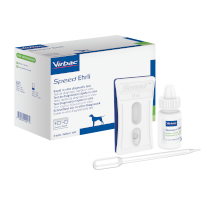
Rapid tests
Speed Ehrli
Test for the qualitative detection of circulating antibodies to Ehrlichia canis in dogs.
Canine ehrlichiosis is a bacterial infectious disease caused by a Rickettsia bacterium, Ehrlichia canis, and transmitted to dogs by tick bites.
- Thanks to a simple blood test, Speed Ehrli enables rapid detection of anti-Ehrlichia canis antibodies in dogs, in just 15 minutes, the time it takes for a consultation.
-
Speed Ehrli enables early detection during the acute phase of the disease, before the infection becomes chronic.
For veterinary use only.
Product specifications
| Sample | Anticoagulated whole blood, serum, plasma |
|---|---|
| Species | Dogs |
| Manipulation | 2 minutes |
| Time-to-results | 15 minutes |
| Storage | Long shelf life of 24 monts at room temperature (2°C - 30°C) |
| Presentation | Box of 6 or 20 tests |
Why using Speed Ehrli ?
Canine ehrlichiosis is the result of the white blood cells infection by an intracellular Gram negative bacterium (Rickettsia) of the Ehrlichia genus, the most common of which is Ehrlichia canis. The disease's vector is the brown tick (Rhipicephalus sanguineus).
Ehrlichia is present throughout Europe. In endemic areas (around the Mediterranean), seroprevalence can reach 20%, depending on the region (2).
After an acute phase of 1 to 4 weeks, which may be characterized by acute fever, depression and loss of appetite, the infection becomes chronic, sometimes leading to haematological and biochemical disorders: anaemia, hypoproteinemia, coagulation disorders (3) or variable joint disorders.
Asymptomatic or sub-clinical animals are common, and the disease may go undetected for a long period.
In front of polymorphous clinical picture, serological diagnosis, i.e. detection of the presence of antibodies, is essential to confirm exposure to the bacterium.
When to use Speed Ehrli ?
Speed Ehrli is used to detect the presence of antibodies which may indicate recent contamination or chronic carriage of Ehrlichia Canis. Ehrlichiosis detection peaks in spring and autumn, due to the increased activity of tick vectors.
Speed Ehrli may be indicated in the following cases :
- In endemic areas, or in environments where ticks are present in large numbers, screening of potential animals carriers before they are brought into the community, and implementation of appropriate sanitary measures.
- Prevention of contamination risks during blood transfusions.
- In the presence of polymorph symptoms such as fever, loss of appetite, haematological or joint disorders compatible with tick-borne disease
Diagnosis is sometimes difficult due to variable signs, and a combination of blood tests is often required to identify the disease.
Quick guide
For complete instruction, please refer to the product notice.
1. Add 1 drop of sample into each sample well.
2. Add slowly 5 drops of reagent into each sample well.
3. Read the result at 15 minutes.

Speed Ehrli performances
Evaluation of the performances of Speed Ehrli and other rapid tests in comparison to the reference method Indirect ImmunoFluorescence (IFI) in 97 dogs coming from endemic and non-endemic zone.
| Reference method | Indirect ImmunoFluorescence |
|---|---|
| Sensitivity vs ref | 97% |
| Specificity vs ref | 95% |
References
(1) Martin C. - Les Ehrlichioses du chien, étude bibliographique, diagnostic et comparaison de trois kits de diagnostic serologique rapide de l’ehrlichiose monocytaire. Thèse Med Vet Lyon, 2004.
(2) DAVOUST P., PARZY B. Actualité des ehrlichioses. Bull.Soc.Vet.Prat.France., 1995, 79(4), 183-204
(3) DAVOUST P. et coll. : Ehrlichiose canine expérimentale. Etude clinique et thérapeutique. Rec. Med. Vet, 1991, 33-40
Websites
Discover the guidelines about feline and canine vector-borne diseases on the European Scientific Councel Companion Animal Parasitic (ESCCAP) website:
Related products



